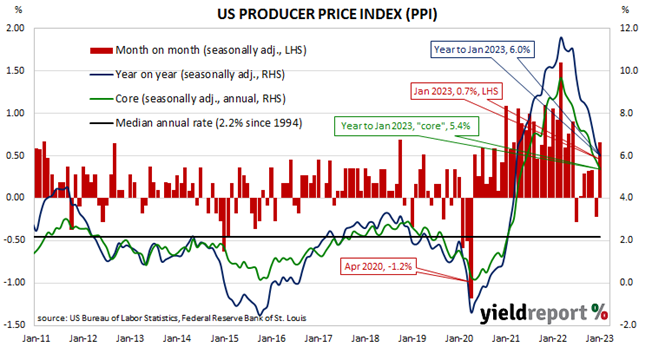Summary: US producer price index (PPI) up 0.7% in January, rise greater than expected; annual rate slows to 6.0%; “core” PPI up 0.3%; inflation “hot”; Treasury yields rise noticeably, rate-rise expectations soften; goods prices up 1.2%, services prices up 0.4%.
Around the end of 2018, the annual inflation rate of the US producer price index (PPI) began a downtrend which continued through 2019. Months in which producer prices increased suggested the trend may have been coming to an end, only for it to continue, culminating in a plunge in April 2020. Figures returned to “normal” towards the end of that year but annual rates through 2021 and 2022 have been well above the long-term average.
The latest figures published by the Bureau of Labor Statistics indicate producer prices increased by 0.7% after seasonal adjustments in January. The rise was slightly greater than the 0.5% increase which had been generally expected and in contrast with December’s 0.2% fall after it was revised up from -0.5%. On a 12-month basis, the rate of producer price inflation after seasonal adjustments and revisions slowed from 6.5% in December to 6.0%.
Producer prices excluding foods and energy, or “core” PPI, increased by 0.5% after seasonal adjustments. The result was higher than the expected 0.3% as well as December’s 0.3% rise but the annual rate still slowed from December’s revised figure of 5.7% to 5.5%.
“In other words, no matter how you cut it, inflation was hot,” said NAB Head of Market Economics (Markets), Tapas Strickland. “The latest data supports the Fed view of…continuing to raise rates and hold them there higher for longer.”
US Treasury bond yields rose noticeably on the day. By the close of business, the 2-year Treasury yield had added 4bps to 4.65%, the 10-year yield had gained 7bps to 3.87% while the 30-year yield finished 8bps higher at 3.92%.
In terms of US Fed policy, expectations of higher federal funds rates over the next 12 months softened a touch. At the close of business, contracts implied the effective federal funds rate would average 4.66% in March, 8bps higher than the current spot rate, and then climb to an average of 4.855% in April. May futures contracts implied a 5.04% average effective federal funds rate while December contracts implied 5.07%.
The BLS stated higher prices for final demand good rose by 1.2% on average. Prices of final demand services rose by 0.4%.
The producer price index is a measure of prices received by producers for domestically produced goods, services and construction. It is put together in a fashion similar to the consumer price index (CPI) except it measures prices received from the producer’s perspective rather than from the perspective of a retailer or a consumer. It is another one of the various measures of inflation tracked by the US Fed, along with core personal consumption expenditure (PCE) price data.


